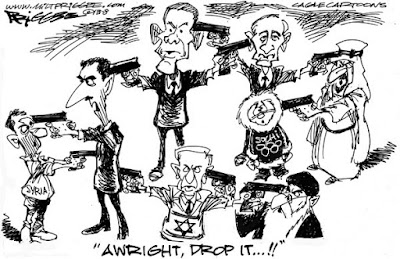Iran’s Supreme Leader, Ayatollah Ali Khamenei released an incendiary video this week, describing the “humiliation” the U.S. would experience if it were to invade Iran. The video reminds the viewer of the protracted American wars in Iraq and Afghanistan and of Hezbollah’s perceived “victory” over Israel in 2006.
The video, as inflammatory as it may be, is as meaningful as any propaganda produced by any government; which is to say, it’s dubious at best. Iran has never started a war in the modern era. Its standing orders are to never launch a first strike and the success of the Iranian nuclear deal means we will likely not go to war with Iran anytime soon. That does not keep Iran from trolling the United States more than any country, group, or individual (and we just tend to remember that kind of sh*t talk).
The video, as inflammatory as it may be, is as meaningful as any propaganda produced by any government; which is to say, it’s dubious at best. Iran has never started a war in the modern era. Its standing orders are to never launch a first strike and the success of the Iranian nuclear deal means we will likely not go to war with Iran anytime soon. That does not keep Iran from trolling the United States more than any country, group, or individual (and we just tend to remember that kind of sh*t talk).
Iran is the industrial, military, and economic Shia counterweight to Saudi Arabia, the preeminent Sunni monarchy in the Middle East. Iran considers the Middle East their backyard, sending money, weapons, and supplies to Shia Islamic groups in neighboring countries in an attempt to destabilize or undermine the Sunni (or secular) leadership there. The Islamic Republic is currently projecting power all over the region, well beyond the borders of the old Persian Empire: they assist Houthi rebels in Yemen, fund and supply paramilitary organizations like Muqtada al-Sadr’s Mahdi Army in Iraq and Hezbollah in Syria and Lebanon as well as others, all fighting Sunni paramilitary organizations funded by members of the Gulf Cooperation Council (GCC), such as the al-Nusra Front. These Iranian-funded and Saudi-funded groups both fought U.S. troops during the Iraq War (though likely not side-by-side). The goal is to keep the fighting there, and not in Iran.
Those are the bare basics of the Sunni-Shia religious civil war everyone is always talking about. There are of course other issues in play. This is the Middle East, after all. The promise of military support from United States is one of the pillars of Saudi (and global oil market) security. Israel is the U.S.’ eternal ally. America has made promises in to fight ISIS in the region, alongside (but not with) Iranian-backed Iraqi militias, Syrian rebels, and Sunni-funded al-Qaeda groups. Now the Russians are sending more advisors and weapons to the Asad regime (which is also an Iranian client state). All this means we could be right back to where we started.
The nuclear deal also doesn’t rule out a military strike from Israel. Israel has long depended on security and defense guarantees from the United States and is not averse to starting wars with countries it deems a threat to their long-term survival. As an added bonus, Israel already has nuclear weapons. Benjamin “Bibi” Netanyahu’s coalition government depends on a motley mixture of right-wing political parties and ultra-orthodox Jewish parties, who are convinced Iranian leaders said they want to wipe Israel off the face of the Earth, despite the fact that this phrase is a misquote from a bad translation. And a surprise from Israel is not unheard of.
So what would the United States be up against? Would we be as humiliated as the Supreme Leader’s video suggests? Not likely. Much of Iran’s military hardware predates the 1979 Islamic Revolution and the resulting arms embargo. Because of that embargo, a lot of the Iranian defense industry is homegrown, which means the Iranians are not limited to arms deals with foreign powers. They can build their own tanks, fighters, and subs (more on those later). Anything not built in Iran or coming from Russia is likely aging very poorly. Overall defense spending is relatively (to the worldwide arms industry) miniscule, around $6 billion, especially in comparison to the GCC.
(Keep in mind, U.S. defense spending wouldn’t even fit on the scale above.)
Iran has about a half million troops on active duty, not including the 125,000 in the Revolutionary Guard Corps (IRGC). As the name suggests, the IRGC are the most devoted members of the Iranian military. All Iranian forces take men as young as 18, but the Basij Forces (meaning “Mobilization of the Oppressed”) will take a male as young as 15. The Basij mainly acted as human minesweepers and led human wave attacks to great effect during the Iran-Iraq War.
The Iranian conventional forces have 4 branches: The Islamic Republic of Iran Army (IRIA), Navy (IRIN), Air Force (IRIAF), and Air Defense Force (IRIADF). Iran’s conventional military are considered “severely limited, relying heavily on obsolescent and low quality weaponry.” The IRIA has a large tank force of over 1600 but as with other materiel, it’s aging rapidly. They are able to make their own tanks (the most recent based on the design of the M47M Patton), but not in significant numbers and the U.S. has effective anti-armor tactics.
Read More >>



















0 comments:
Post a Comment